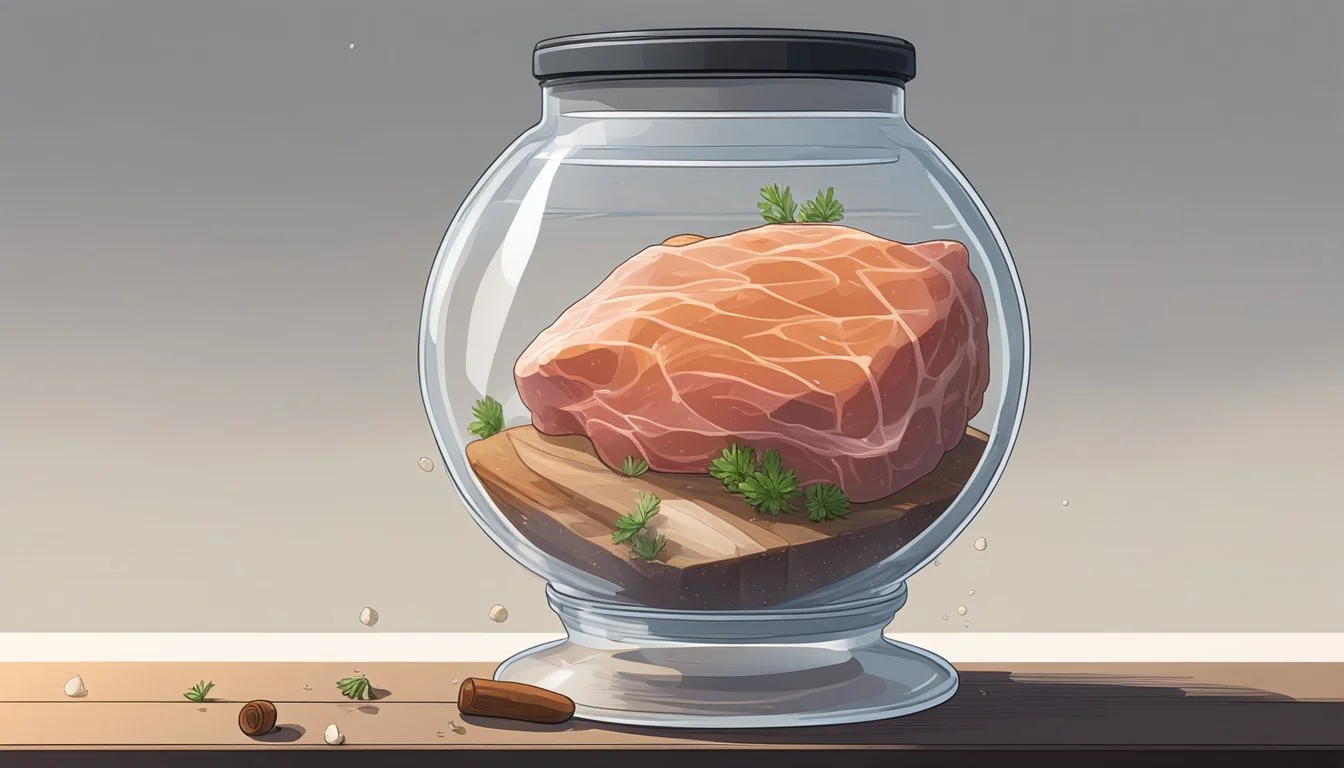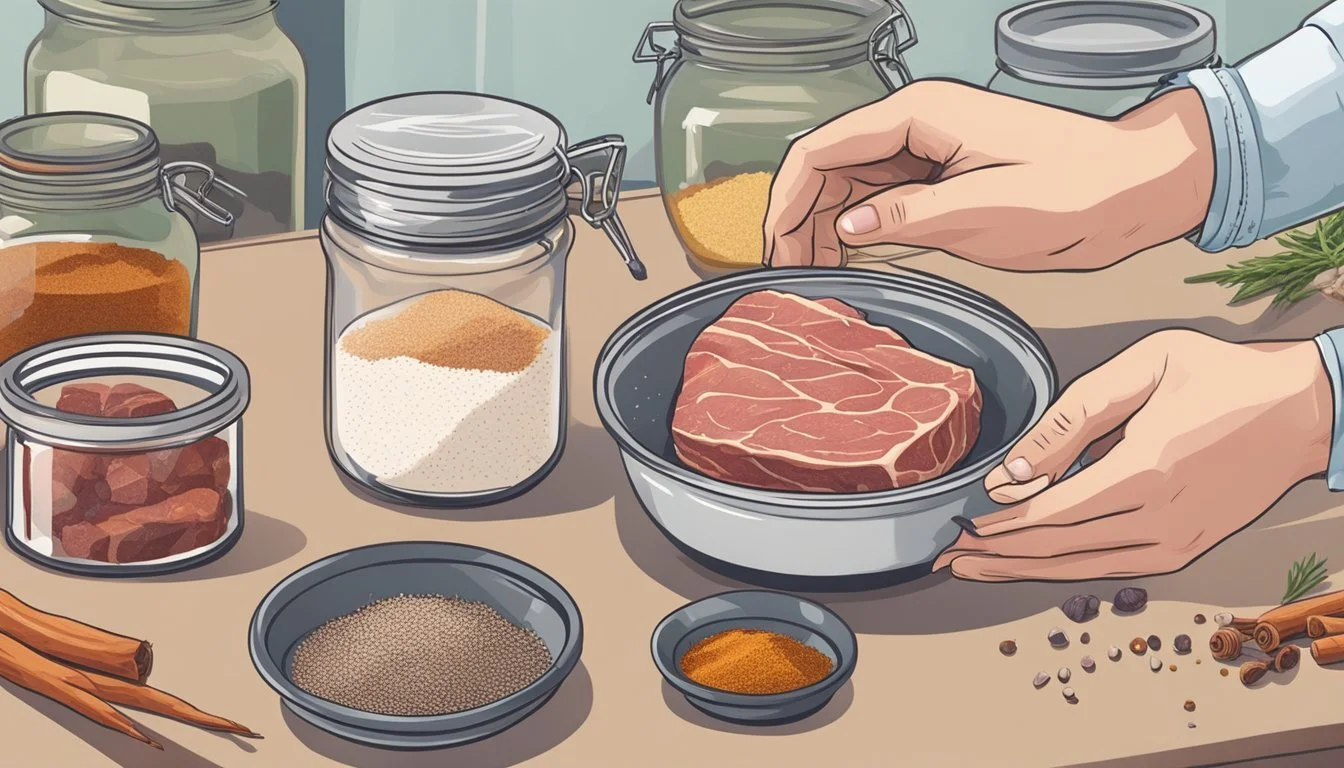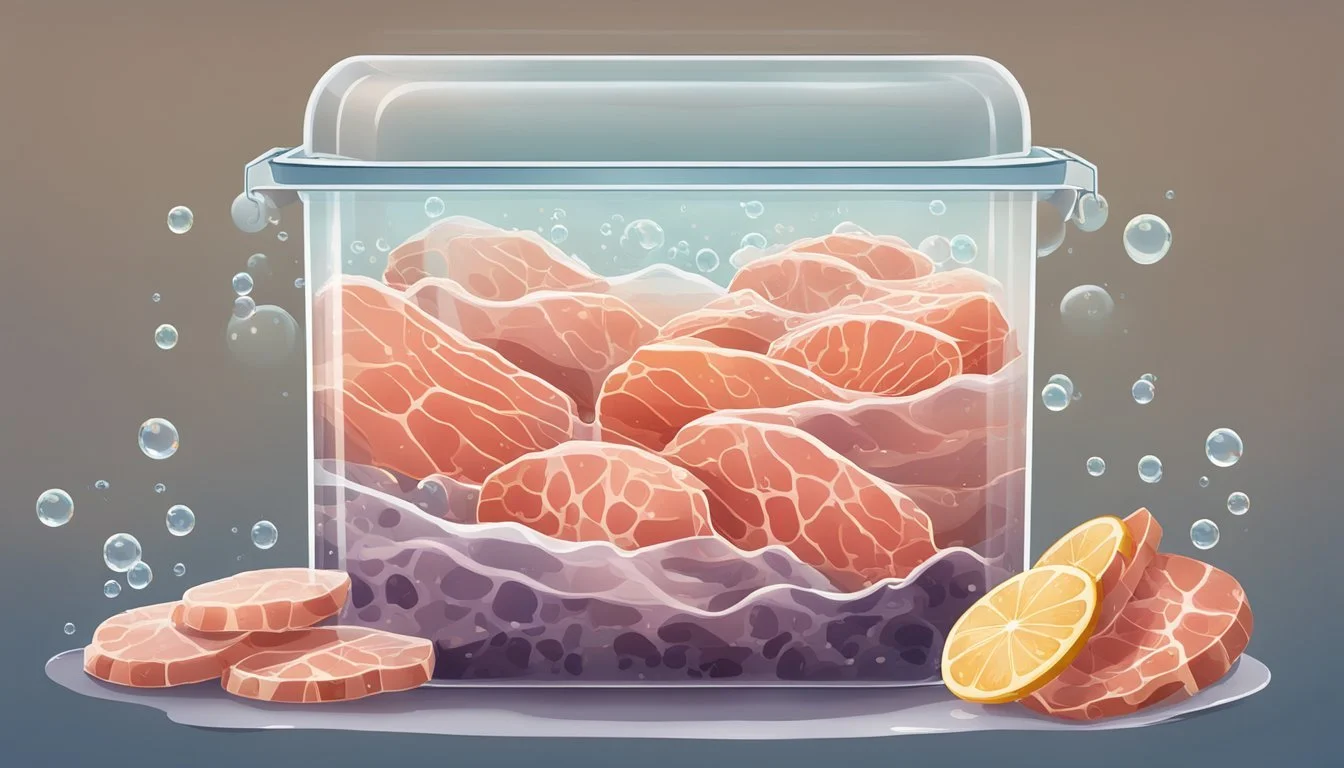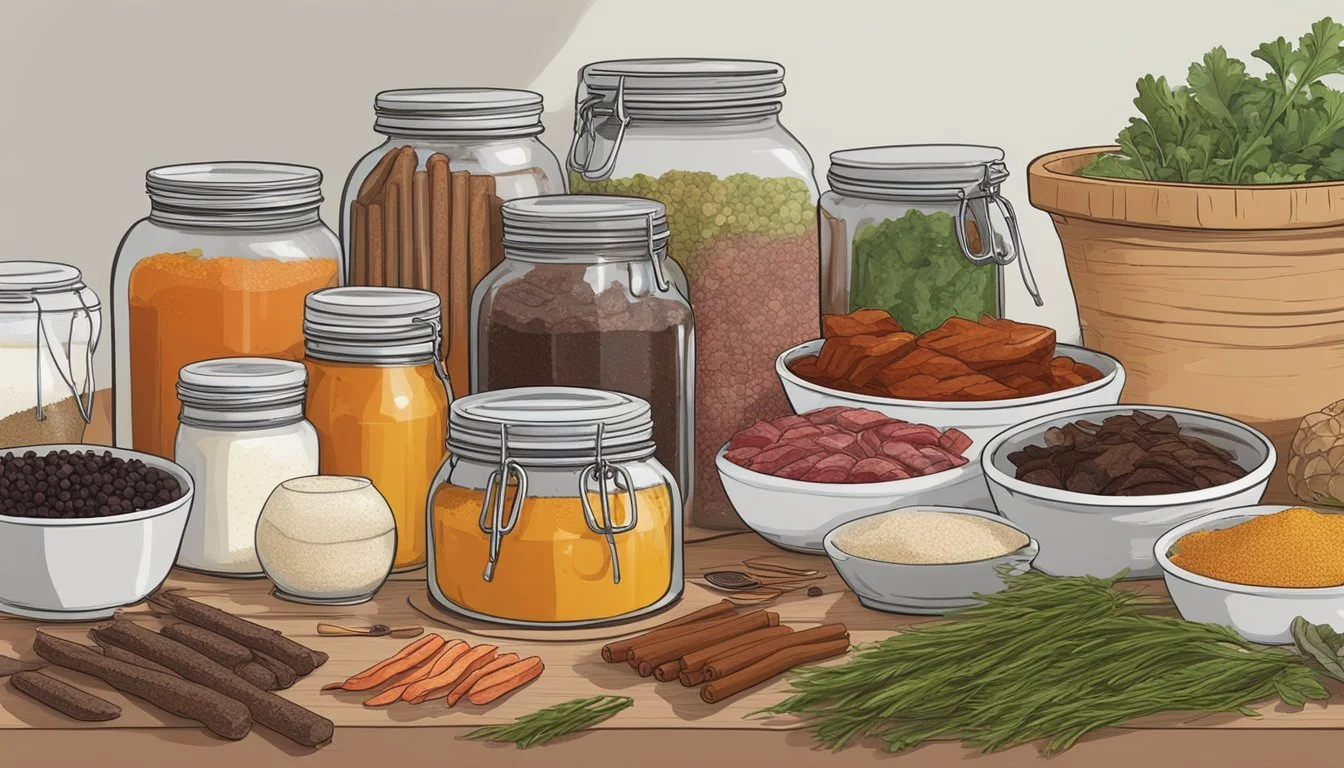How to Ferment Jerky
A Guide to Crafting Flavorful Dried Meat
Fermenting jerky is an ancient technique that transforms raw meat into a savory, preserved delicacy through controlled drying and flavor development. This process not only extends the shelf-life of meat but also imparts complex flavors and desirable textures that are characteristic of high-quality jerky. The process begins with selecting the right cut of meat, typically lean cuts are preferred to minimize fat, which can spoil during fermentation and drying.
Before fermentation, the meat must be prepared correctly to ensure safety and flavor. It is sliced into consistent, thin strips that allow for even drying and thorough seasoning. A precise mixture of curing salts, spices, and sometimes sugar is applied to the meat to inhibit the growth of unwanted bacteria and to kickstart the fermentation process, which is vital for developing the jerky's flavor and texture. The marinated meat strips are then laid out and dried at a low temperature until they reach the desired level of moisture reduction, ensuring the jerky is shelf-stable and chewy.
The conditions under which jerky ferments and dries are carefully controlled to reduce the risk of pathogenic bacteria and ensure a safe product. Temperatures are monitored to stay within safe limits, and equipment used during the process is kept clean to prevent contamination. The result is a protein-rich, portable snack that has been enjoyed for centuries and remains a favored treat for its unique taste and convenience.
Understanding Jerky and Its History
Jerky is a form of dried meat that dates back thousands of years. It is created by removing the moisture from meat to prevent spoilage, allowing it to be preserved for extended periods. The name "jerky" comes from the Quechuan word ch'arki, which translates to "dried meat."
Origins:
Historically, jerky was made using various meats, including beef, poultry, pork, venison (What wine goes well with venison?), and wild game. The process of creating jerky emerged from the necessity of food preservation in times before refrigeration. The drying technique provided a way for ancient civilizations to store surplus meat.
Nutritional Value:
Jerky is known for being a dense source of nutrition. By drying the meat, its weight is reduced, making it portable and convenient for travel. Fermenting jerky, a method involving beneficial bacteria to cure the meat, adds to its shelf life and imparts a unique flavor.Meat Selection:
Beef: Lean cuts are popular choices due to their low fat content, which assists in the drying process.
Poultry: Generally lower in fat, poultry jerky must be thoroughly cooked to avoid pathogens.
Pork: Requires careful handling to ensure safety before the drying process.
Venison and Wild Game: Often used for their robust flavors and traditional ties to jerky making.
Modern Evolution:
While originally a survival food, jerky has evolved into a gourmet snack enjoyed across various cultures, with flavors and textures reflecting local tastes and culinary traditions. The methods have also improved, utilizing modern techniques to enhance safety and consistency, while still honoring the historical essence of jerky making.
Selecting the Right Meat
When making jerky, one's success begins with choosing the proper meat. This involves selecting the right type, preparing it appropriately, and ensuring it's trimmed and sliced correctly for optimal drying and flavor.
Choosing the Meat Type
The choice of meat is paramount in jerky making; beef is traditionally favored for its rich flavor and widespread availability. However, alternatives such as poultry, pork, venison, and other wild game can also be used. One should opt for lean meat cuts to avoid spoilage, as fat does not dry and can cause the jerky to go rancid. Choosing lean cuts also simplifies the preparation and drying process.
Meat Choices:
Beef: Top round, bottom round, flank steak
Poultry: Turkey or chicken breast
Pork: Lean ham, loin
Venison/Wild game: Leg or loin cuts
Preparing the Meat
For optimal texture and ease of eating, the meat should be prepared by cutting with the grain. This also helps maintain the jerky's structure. The meat must also be safe for consumption, so one should start with a fresh, high-quality piece of meat, ensuring it has been properly stored and handled before the drying process begins.
Preparation Steps:
Inspect the meat for freshness.
Freeze the meat slightly to aid in slicing.
Trimming Fat and Slicing
Before slicing the meat into strips, all excess fat should be trimmed off to maximize the jerky's shelf life. One should also remove any gristle to ensure the resulting jerky is tender and enjoyable to chew. Uniformity in slice thickness is key, as it promotes even drying and consistent texture.
Trimming Guidelines:
Fat: Remove all visible excess
Gristle: Discard to prevent chewy textures
Slice Thickness: Aim for uniformity, about 1/8 to 1/4 inch thick
By following these careful selection and preparation steps, one sets the stage for creating high-quality, delicious jerky.
Marinades and Spices
Marinating and seasoning are critical steps in the fermentation process of jerky, as they impart flavor and tenderize the meat. The careful combination of spices and marinade ingredients ensures a palatable balance that complements the natural taste of the dried meat.
Creating the Marinade
A successful marinade for jerky begins with a base of soy sauce and Worcestershire sauce, which provides both a salty foundation and a complex flavor profile. To this base, one typically adds brown sugar or honey to introduce a touch of sweetness. Sweetness often helps to balance the umami and salty flavors from the soy and Worcestershire sauces. The acid component is commonly addressed with white vinegar, which assists in tenderizing the meat and enhancing the mingling of flavors.
Proportions for a basic marinade:
Soy sauce: 1 cup
Worcestershire sauce: 1/2 cup
Brown sugar/honey: 2-3 tablespoons
White vinegar: 1/4 cup
Selecting Spices and Seasonings
The spices and seasonings chosen can vary widely, but there are staples in the jerky-making process that consistently result in a well-received product. Garlic powder and onion powder are essential for a savory background note. Black pepper provides a warm, piquant edge, while red pepper flakes offer a hint of heat.
Recommended spice mix:
Garlic powder: 1 tablespoon
Onion powder: 1 tablespoon
Black pepper: 2 teaspoons, freshly ground
Red pepper flakes: 1/2 teaspoon
By selecting quality ingredients and carefully measuring spices and marinade components, one can ensure that the jerky will emerge with a well-balanced and satisfying flavor after the fermentation and drying processes.
Fermentation Process
In the fermentation process of making jerky, controlling temperature, ensuring a clean environment, and monitoring time are crucial to inhibit harmful bacteria and encourage desirable microbial activity.
Fermenting Meats at Home
When fermenting meats at home to make jerky, one begins with selecting quality cuts of meat that are trimmed of excess fat and sliced uniformly for consistent drying. The meat is then seasoned with a blend of salts, sugars, and spices, and a starter culture—often containing beneficial bacteria like Lactobacillus—is added to initiate fermentation. This mixture supports the growth of desirable bacteria, which outcompete potential harmful microorganisms.
Temperature and Environment Controls
Precise control over the fermentation environment is vital to ensure safety and quality. Fermentation should be carried out at temperatures that support beneficial bacterial growth but inhibit the proliferation of harmful bacteria like Staphylococcus aureus. Ideally, fermentation occurs just above refrigeration temperature, between 55°F and 60°F (13°C and 16°C). The area must be kept clean to minimize the risk of contamination.
Duration and Microbial Activity
The appropriate fermentation duration ranges from 24 to 48 hours, depending on the recipe, meat thickness, and the ambient conditions. Throughout this period, desirable microorganisms metabolize sugars, lowering the pH of the meat which creates an inhospitable environment for pathogens like those leading to trichinosis or other foodborne illnesses. The jerky is considered adequately fermented when it reaches a pH below 5.3, which signifies that bacterial growth has been effectively controlled.
Drying the Meat
Drying the meat is a crucial step in jerky production, where the goal is to remove moisture while preserving flavor and safety. Achieving the right dryness involves using appropriate equipment, temperature regulation, and handling techniques to ensure the jerky is dehydrated uniformly.
Using a Dehydrator
The dehydrator is the most consistent tool for drying jerky. Meat should be arranged in a single layer with none of the pieces touching or overlapping. Set the temperature of the dehydrator to 160°F and let the jerky dry until it is firm, yet pliable. Using a meat thermometer, ensure the internal temperature of the jerky reaches at least 160°F to properly eliminate bacteria.
Oven Drying Method
For oven drying, preheat the oven to the lowest setting, typically around 150°F to 170°F. Place marinated meat strips on baking sheets covered with foil or parchment paper. Prop the oven door open slightly to allow moisture to escape and air circulation—some ovens have a fan for this purpose. The process could take several hours, and it's vital to periodically check the internal temperature of the jerky using a meat thermometer, aiming for 160°F.
Alternative Drying Methods
While dehydrators and ovens are common for drying jerky, alternative methods exist. The microwave is not typically recommended due to difficulty in achieving an even dryness. Sun-drying is traditional but less controlled, and requires a dry, warm climate with adequate air circulation. Regardless of the method, it is imperative that jerky reaches an internal temperature that is safe for consumption.
Flavor and Texture Control
In the process of fermenting jerky, careful attention to flavor and texture is paramount. The right balance of seasoning and marination will not only enhance flavor but also ensure the right tenderness of the meat.
Balancing Flavors
To achieve a well-balanced flavor in fermented jerky, one must consider the interplay of sugar and spices during marination. Sugar acts not only as a flavor enhancer but also contributes to the meat's browning, which can affect the taste. The choice of spices, from garlic powder to more complex blends, determines the jerky's final flavor profile. The incorporation of a mild acid, like vinegar in the marinade, can subtly enhance the spices' warmth and depth.
Sugar: Purpose - Enhance sweetness and browning
Spices: Purpose - Determine flavor profile
Acid (e.g., vinegar): Purpose - Enhance spice flavors
Achieving Desired Texture
The texture of jerky is influenced during the marinating stage and the subsequent drying process. A tenderizer, such as acidic fruit juices or commercial meat tenderizing products, can be added to the marinade to create a more tender chew. The drying temperature and time are crucial; drying at a low temperature, like 140 degrees Fahrenheit, for an extended period allows for controlled moisture removal, which affects the jerky’s bite. The meat should bend and crack but not break, indicating that it has reached the desired texture.
Drying Guidelines for Texture:
Marinade with tenderizer to soften meat fibers
Dry at low temperatures (140°F recommended)
Achieve a firm texture that bends and cracks
Storage and Preservation
The longevity and safety of jerky are heavily dependent on storage and preservation methods. Understanding the optimal techniques is crucial to avoid spoilage and extend the shelf life of dried meats.
Proper Packaging
When packaging jerky, one must consider materials that limit exposure to air and moisture. Vacuum packaging is highly effective as it removes air, thereby reducing the risk of spoilage. For those who may not have access to vacuum sealing equipment, plastic food storage bags with as much air pressed out as possible serve as an alternative. Glass jars with tight-sealing lids also provide an airtight environment, protecting the jerky from oxygen and humidity.
Recommended Packaging Options:
Vacuum-sealed bags
Plastic food storage bags (air removed)
Glass jars with tight seals
Long-Term Storage Solutions
For extended preservation, controlling the environment is key. The freezer offers the best solution for long-term storage of jerky, with the possibility of maintaining its quality for several months to a year. Individuals should ensure that the jerky is completely dry and at room temperature before freezing to prevent ice crystal formation. For outdoor enthusiasts, such as backpackers and campers, where freezing is not an option, jerky should be consumed within a few days of packaging or stored in a cool, dry place away from direct sunlight.
Freezing:
Duration: Several months to a year
Condition: Jerky should be dry and at room temperature
Packaging: Use vacuum-sealed bags or airtight containers
By carefully packaging and choosing the proper storage solutions, one can effectively preserve the quality of jerky for both immediate consumption and future use.
Safety and Sanitation
In the process of fermenting jerky, it is critical to prioritize safety and sanitation to prevent foodborne illness. Ensuring that harmful bacteria, such as Staphylococcus aureus and fecal bacteria, do not contaminate the meat is paramount.
Preventing Contamination
Storage: Meat should be stored at safe temperatures to prevent the growth of harmful bacteria. Refrigeration at 40°F (4.4°C) or below is essential, and freezing meat at 0°F (-18°C) can inhibit bacterial growth during storage. When thawing meat, one should do so in the refrigerator, under cold running water, or in the microwave—never at room temperature.
Handling: Safe handling practices are imperative to avoiding contamination. Always wash hands thoroughly with soap and warm water before and after handling meat. All equipment and surfaces that come into contact with the meat should be sanitized before use to eliminate any bacteria present.
Meat Safety: Select high-quality, fresh meat from reputable sources to guarantee meat safety. Meats should be inspected and processed following strict safety guidelines to prevent any risk of foodborne illness.
Safe Handling and Practices
Preparation: Before fermenting the jerky, surfaces, equipment, and hands must be clean. Use an antibacterial cleaner on cutting boards and utensils, and wash hands with soap for at least 20 seconds before handling the meat.
Fermentation: Carefully monitor the fermentation process, ensuring that the pH level drops sufficiently to create an acidic environment where bacteria struggle to survive.
Drying: The drying stage should achieve a water activity (a_w) level low enough to inhibit bacterial growth. It is crucial that drying occurs uniformly and at the correct temperatures to prevent the survival of any bacteria.
Jerky Recipes and Variations
Creating jerky involves marinating slices of meat with seasonings for flavor, and then drying them to produce a savory, long-lasting snack. The variety of jerky recipes allows for many taste profiles, from classic beef to exotic meats, each with unique flavor compounds.
Beef Jerky Recipes
Traditional: A basic beef jerky recipe combines soy sauce, Worcestershire sauce, black pepper, onion powder, and garlic powder. Marinate the thinly sliced beef for at least 6 hours to let the flavors infuse.
Sweet and Spicy: Add honey and red pepper flakes to the traditional marinade for a mix of sweetness and heat.
Smokey: Incorporate liquid smoke into the marinade mix for a deep, smoky note, reminiscent of outdoor grilling.
Alternative Meat Jerky Recipes
Turkey Jerky: Swap beef for turkey to create a leaner option. Season with a blend of soy sauce, apple cider vinegar, and brown sugar for a tangy, slightly sweet jerky.
Game Meat Jerky: Venison or bison provide a wild twist to jerky, often requiring more robust seasonings such as juniper berries and rosemary to complement the gamey flavor.
Fish Jerky: Salmon or trout can be turned into jerky too; typically, brined in a solution of salt, sugar, and spices before drying to ensure a flavorful result.
These recipes only scratch the surface of the rich world of jerky variations, with each ingredient carefully chosen to enhance the natural taste of the selected meat.
Nutritional Information and Health Considerations
When fermenting jerky, one prioritizes both the flavor and the nutritive value of the meat. Lean meats such as beef, chicken, or turkey are commonly used due to their lower fat content and higher protein density. Fermented jerky retains these proteins, which are crucial for muscle repair and overall body function.
The fermentation process can potentially introduce beneficial bacteria that may aid in gut health, thus contributing positively to the immune system. Nevertheless, it's important to be mindful of the sodium nitrate levels in the product. Sodium nitrate is often used for preservation, but high consumption can be linked to adverse health outcomes. Opting for natural fermentation methods can be a healthier alternative.
Here's a brief overview of key nutritional aspects to consider:
Protein: A staple nutrient in jerky, essential for body repair and maintenance.
Sodium: Necessary for electrolyte balance but should be consumed in moderation.
Carbohydrates: Generally low in properly prepared jerky, making it a suitable snack for low-carb diets.
Fat: Leaner meats yield a product with lower fat content, which can be beneficial for heart health.
Nutrition of fermented jerky can vary based on the ingredients and preparation method. Consumers should seek options aligned with their nutritional needs, especially when it comes to sodium and additives. Opting for naturally fermented jerky could be the healthier choice, providing the benefits of fermented foods while enjoying a savory snack.
Jerky for Outdoor Activities
Jerky is a quintessential food choice for outdoor enthusiasts. Its long shelf life, portability, and nutritious profile make it a favorite among campers, backpackers, and hunters. This dried meat is high in protein and energy, providing outdoor adventurers with the sustenance they require for energy-intensive activities.
Campers often turn to jerky because it’s lightweight and doesn't require refrigeration. It can easily be packed into a backpack, taking up minimal space and providing a hassle-free meal option. Whether hiking through trails or setting up camp, jerky is a convenient, no-prep food source.
Backpackers benefit from jerky due to its nutritional content. It provides a compact energy source that is vital for long treks. As a versatile snack, it can be enjoyed on its own or added to meals like soups or beans for an extra protein boost.
For hunters, jerky is not only a practical snack but also a tradition. Many hunters create their own jerky from their game, turning a successful hunt into a sustainable food source for future excursions.
Here is a simple breakdown of why jerky is ideal for outdoor activities:
Portability: Takes up little space and is easy to carry.
Durability: Resists spoilage in various weather conditions.
Energy: High in protein, which is essential for sustained physical activity.
Ease of Use: Ready to eat with no preparation needed.
In conclusion, jerky stands as a reliable food companion for those who immerse themselves in nature. It offers the necessary nutrients and practicality for a range of outdoor pursuits.
Troubleshooting Common Jerky Issues
When crafting jerky, it is crucial to manage moisture content and bacterial growth to prevent both over-drying and under-fermentation, which can lead to undesirable texture and potential illness.
Dealing with Over-Dried Jerky
Symptoms: Jerky becomes overly hard or brittle, indicating excessive moisture loss.
Causes: Typically occurs when jerky is left to dry for too long or at too high a temperature.
Solution: To rehydrate, place the jerky in a microwaveable container with a small container of water. Microwave with the lid on loosely for about one minute; the steam will add moisture back to the jerky. If the jerky has not softened sufficiently, repeat the process in short intervals.
Addressing Under-Fermentation
Symptoms: Jerky is too moist and may have a spongy texture, increasing the risk of bacterial growth.
Causes: Insufficient drying time or low temperature during the drying process.
Preventive Measures:
Temperature Control: Ensure the dehydrator or oven is preheated to at least 140 degrees Fahrenheit before adding the meat.
Uniformity: Cut meat into even strips for consistent drying.
Air Circulation: If using an oven, keep the door slightly open with a utensil to allow moisture to escape.
Solution: If under-fermentation is detected early, extend the drying time and check regularly until the jerky has reached the desired texture. If bacterial growth is suspected, it's safer to discard the batch to prevent illness.
Advanced Techniques and Equipment
In the art of making jerky, precision and proper equipment can elevate the quality of the final product. Advanced techniques involve meticulous temperature control and specialized tools to ensure consistency and safety.
Using a Meat Thermometer
A critical tool in the jerky-making process is a meat thermometer. This essential tool ensures that the meat reaches the safe temperature of 160 degrees Fahrenheit for beef or 165 degrees Fahrenheit for poultry, effectively eliminating harmful bacteria. It's advisable to use a meat thermometer that provides accurate and quick readings.
Recommended Types:
Instant-read Thermometer
Digital Probe Thermometer
Selecting a High-Quality Dehydrator
The cornerstone of dehydrating jerky is a reliable dehydrator. A high-quality dehydrator ensures even heat distribution and has a fan for consistent air flow, critical for drying meat evenly. Look for models with adjustable temperature settings that can maintain around 155 degrees Fahrenheit, as recommended by food safety guidelines.
Features to Consider:
Temperature Control
Timer Function
Even Airflow Distribution
Optimizing your Oven
For those without a dehydrator, an oven can be utilized to make jerky at home. To optimize an oven, arrange meat on a wire rack over a baking sheet to allow for proper heat circulation. Prop the door open slightly with a wooden spoon to let moisture escape, and set the oven to the lowest temperature, ideally around 140 to 170 degrees Fahrenheit. Use an oven thermometer to confirm accurate temperatures throughout the process.
Buying vs. Making Jerky
When choosing between store-bought and homemade jerky, consumers typically consider factors such as cost, quality, and nutritional value.
Comparing Costs
Store-bought jerky can vary in price, but based on average costs, one might spend $55.92 monthly for moderate consumption. This estimate includes purchasing beef jerky totalling 20 ounces per month.
Quantity: 20 oz.
Cost: $27.96 (per purchase)
Making jerky at home involves initial investments in equipment and raw materials. One needs to consider the price of ingredients, which can vary by store and region.
Lean beef: Average Price - Variable
Seasonings: Average Price - Variable
Equipment: Average Price - One-time cost
While the upfront cost for making jerky can be higher due to equipment purchases, per ounce the price often lessens with increased production, making it cost-effective over time.
Assessing Quality and Freshness
Homemade jerky presents an advantage in quality and freshness. One has control over the choice of ingredients, ensuring the use of lean meat cuts, and can customize the seasoning to personal preference.
Store-bought jerky, on the other hand, may contain preservatives to extend its shelf life. While convenient, the preservatives and added ingredients can alter the nutritional profile, potentially leading to higher sodium content and other additives that one might prefer to avoid.
Both store-bought and homemade jerky serve as sources of iron and zinc. Nevertheless, by making jerky at home, consumers can keep a closer eye on nutritional values, possibly creating a snack lower in fat and calories compared to some commercially available products.
The Future of Jerky Making
As jerky making advances, enthusiasts and manufacturers alike are keenly observing innovations in meat preservation and emerging trends that could redefine the process and product.
Innovations in Meat Preservation
Innovations in meat preservation are ushering in new methodologies for extending shelf life and enhancing flavor. Dehydrating meat, a core technique in jerky production, is benefiting from technological improvements that allow for more uniform drying processes. This reduces the risk of spoilage and ensures a consistently high-quality product. Researchers are exploring novel preservation methods, such as using natural preservatives derived from plants, which appeal to health-conscious consumers. Additionally, modern home canning techniques are being adapted to preserve the quality of homemade jerky, leading to increased interest in home preservation of meats, including sausages and other cured products.
Preservation techniques being explored include:
High-pressure processing (HPP)
Pulsed electric fields (PEF)
Ultrasonic drying methods
Emerging Trends
Emerging trends in jerky making signal a shift towards exotic flavors and customizable options that cater to diverse palates and dietary requirements. Trends are seeing jerky becoming more than just a snack; it is fast becoming a gourmet item. Consumers are interested in a wider variety of meats, including game meats and ethically sourced options. On the other hand, there is a growing DIY culture that inspires more individuals to try their hand at making jerky at home with innovative kitchen appliances designed for small-batch dehydrating.
Here are the current trends affecting jerky making:
Use of non-traditional meats like salmon, plant-based alternatives, and insect protein
Focus on bold and global flavors, such as Korean BBQ or Chili Lime
Rise in popularity of subscription services offering curated selections of artisanal jerky
Conclusion
Fermenting jerky is a traditional method of preserving meat that not only extends its shelf life but also enhances its flavor profile. The crucial aspect of creating jerky is the dehydration process, which involves removing moisture to inhibit bacterial growth. This significantly preserves the meat, allowing it to be stored and consumed over extended periods.
Preservation: Dehydration through air drying or low-heat methods is effective for meat preservation. When fermenting, salt and beneficial bacteria are added to cultivated meat, creating an inhospitable environment for harmful microbes.
Nutrition: Jerky retains most of its nutritional content, making it a rich source of protein. Necessary vitamins and minerals are concentrated in the drying process, though some vitamin loss may occur.
Protocols: Safety should be the foremost priority when fermenting jerky. Proper sanitation and following correct temperature guidelines are paramount to prevent spoilage and ensure the safety of the final product.
Storage: Once dried and fermented, jerky should be stored in a cool, dry place in airtight containers to maintain its quality.
Consumption: While fermented jerky is a concentrated source of nutrients, consumers should be mindful of its high sodium content.
A methodical approach to fermentation and careful attention to detail can yield a homemade jerky that is both satisfying and nutritious. Fermented jerky offers a harmony of flavor and preservation, embodying an age-old technique that continues to be cherished in various cultures around the world.
















